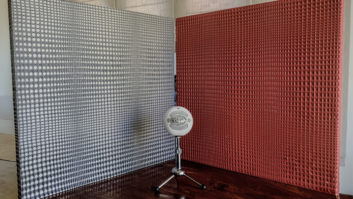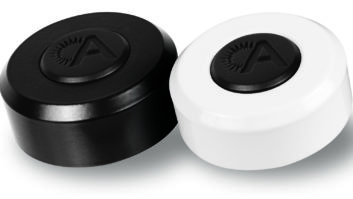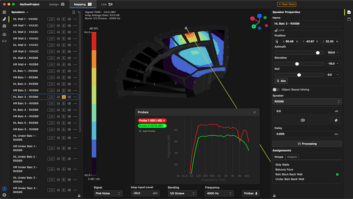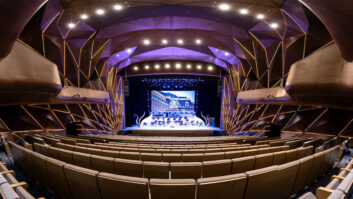The audio involved in most church services today is a blend of spoken word, singing voices and music with instrumentation that ranges from minimalistic— e.g., one piano, organ or guitar—to complex—perhaps something rivaling a Broadway production.
If audio quality is a concern at your church, it likely stems from one of two causes: the clarity (or lack thereof) of the spoken word, or the overall quality and effectiveness of the music. Doing something physical to adjust the former issue almost always affects the latter, so before purchasing that new console, line array or other gear-based solution for the sanctuary, it is crucial to objectively analyze your HOW’s acoustics alongside your perceived needs.
“There’s a tremendous amount of misinformation—and actually, disinformation—in the church market about what works acoustically, and what doesn’t,” offers Nick Colleran of Acoustics First, an acoustics treatment manufacturer based in Richmond, VA. “The key thing is [in prescribing certain acoustic treatments and techniques] is taking into account what kind of service a church is having and what they are trying to accomplish.”
The goal in considering three categories of treatment tools—isolation, diffusion and absorption—is, of course, to create an acoustically pleasing environment in which to listen, speak and perform, one that should provide a relatively flat frequency response with little room-influenced coloration. Often key in treating acoustically troublesome HOWs, diffusion products reflect sound at various angles, which help to break up both standing waves and flutter echo without removing acoustic energy from a given space. Absorption products also combat these negative acoustic problems via reflecting only a portion of the acoustic energy striking it (a value expressed by an absorption coefficient ratio). Both high- and low-frequency absorption products—consisting of many types of wall-mounted foams and a seemingly endless variety of bass traps—e.g., Helmholtz resonators—can offer the right balance. Together, effective diffusion and absorption can make even the most acoustically offensive room more usable, but this can often involve experimentation and a detailed analysis of a room’s frequency response. And, of course, as in any commercial application of acoustic treatment, it is absolutely imperative to use Class A fire-rated products.
Auralex Acoustics’ Josef Milton notes, “The most common needs are similar to that of any other large room: taming slap back echo, controlling reverberation and maintaining speech (and/or musical) intelligibility. [Modern] HOW venues require an acoustical treatment plan that addresses a space that makes use of both traditional and contemporary music while maintaining a healthy balance of treatment to best satisfy both. Another distinctive characteristic of house-of-worship venues are the acoustical anomalies that originate from unusually tall or dramatically peaked ceilings. We usually address this with acoustical panels or clouds such as our Auralex ProPanel clouds, ProBaffles and ProBanners.”
“Now that contemporary music and instrumentation has gained more popularity in houses-of-worship, we see many more requests to help tame louder instruments such as amplified guitars and basses, keyboards and especially live drum kits,” Milton continues. “Conversely, this has led to a decline in facilities that feature strictly traditional choral and/ or organ music. With this change, the overall acoustic feel of the modern house-of-worship now has a need for a more controlled and tighter RT to help these sound sources become more pleasing to the ear and provide better definition from these instruments. In addition to acoustical treatment within the space, we also employ sound source isolation platforms such as our GRAMMA family of amplifier isolation platforms and HoverMat and HoverDeck drum kit isolation platforms.”
Through all consideration of music-oriented acoustic concerns, Colleran explains that complimentary acoustics aren’t just pleasing; they are crucial to the health and growth of your church. “If they have trouble hearing the voice, soon you will start to lose your congregation because they haven’t gotten anything out of it—unless they are just there to be entertained,” he reasons. “You can leave church with a really bad attitude if your brain has to fight to understand things. If your brain has to work overtime to decipher what is being said, you can literally get a headache. If you’re doing modern music, you might as well optimize the church for the pastor, and let the folks at the console dial in the effects they want. You can add reverberation into the signal, but you can’t take it out very easily.”
If there are obvious acoustic problems in your HOW’s sanctuary, it is important to take an accurate evaluation of its frequency response as well as its Reverberation Time (RT). Luckily, acoustic treatment manufacturers such as Auralex provide services alongside the physical solutions themselves.
“[With] our Free Personalized Room Analysis, we always give the room a full treatment assessment to the best of our ability, but when this breaks the bank, we suggest completing the treatment in phases,” explains Auralex’s Milton. “In any space, no matter the size, the most important places for treatment are the direct reflection points. These are the places where sound immediately hits after leaving the sound source. If these surfaces are highly reflective, this will cause slap back echo as well as other issues. Imagine a laser beam emanating straight from your speaker cones in all cardinal directions: These are the first places you should look to place treatment. In most large rooms, this would generally be the rear wall of a space, the front wall (directly behind the speakers), the sidewalls diagonally (think of the two signals crossing in an ‘x’ pattern) in front and directly horizontal of the speakers, and perhaps the ceiling directly above the speakers, depending on its height and angle. These areas could be the first phase of your overall treatment plan, but it’s important to remember that further treatment could be necessary to help tame the space.”
James Wright of Canadian acoustic treatment firm Primacoustic attests that while a HOW’s particular style of worship is important to consider while dialing in the proper RT, the gear involved—specifically, the loudspeaker coverage scheme—must be considered for maximum acoustic treatment effectiveness. “Traditional worship services and churches present a unique set of challenges,” he explains. “While the reverberation is integral to make the organ and choir sound full and rich, that same reverberant field often blurs the articulation in the sermon, message and announcements. When a church is using several small speakers for coverage, we take the same approach with acoustic treatment, and even distribution of the treatment throughout the church yields the best results. Covering 15-20 percent of the wall surface area is an amount that strikes this balance well. This quantity of acoustic material is easy to fit into spaces throughout the church without being obtrusive. The main benefit is a congregation able to easily hear the message without straining.”
“Greater Piney Grove Baptist Church contacted us to improve the acoustics in their sanctuary, which lacked both speech and music clarity,” explains Glenn Kuras of Atlanta’s GIK Acoustics.

Meanwhile, contemporary music programs at HOWs call for even more acoustic treatment, offers Primacoustic’s Wright. “[Contemporary services] are almost the polar opposite of the traditional worship style,” he explains. “When a worship band—with drums and amplified instruments—gets going, the volume level can often exceed 90 dB. The key issue is control. We have found that covering 20 to 25 percent of the wall surface area is more appropriate in these venues. Placement of the panels is also much more crucial in these facilities. A best practice is to make the ‘stage’ as dead as possible to attenuate reflections from drums (especially when the plexiglass isolation screens are used), open back guitar amps and monitors. The back wall of the stage acts as a giant resonator, filling the room with uncontrolled sound that the sound tech is often unable to fit in the mix. Special consideration also needs to be given to the dispersion pattern of the speakers so that first reflections can be captured. The key in contemporary churches is to let the sound tech have control and not compete with the room.”
Describing a particular recent consultation and subsequent installation, Glenn Kuras of Atlanta’s GIK Acoustics notably addressed both speech and music acoustic concerns in treating the modern HOW. “Greater Piney Grove Baptist Church contacted us to improve the acoustics in their sanctuary, which lacked both speech and music clarity,” he explains. “The sanctuary had a long RT, which made it difficult to comprehend what was being said on the stage, and not everyone in the congregation was hearing what they should be hearing. They asked GIK to help remove those negative effects and make it more uniform across the seating area. The solution was to attenuate the reverberation time. We did that by removing the reflections from the sidewalls that were degrading the intelligibility from the speakers. In this case, we needed to improve both speech and music, so we employed our 244 Bass Traps, which are 5.5-inches thick. The music ministry incorporated instruments that produced lots of low range frequencies, so it was necessary to match this with the performance of a thicker panel. By contrast, other traditional rooms that don’t have as much amplification could use thinner absorption panels, but in the case of Greater Piney Grove, we targeted solutions to improve speech and music.”
Any physical installation will, to some degree, change the look of a HOW’s sanctuary—almost always a concern to the congregation. How this is approached by both the audio team and any acoustics expert and/or treatment products manufacturer is key. “In large HOWs, there can be many people—even whole committees—involved with the design choice,” emphasizes GIK’s Kuras. “Not only are you dealing with varying opinions and aesthetic choices, but there’s often a learning curve involved, too. So where a sound engineer would anticipate the need for acoustic treatments in a studio, the layman on a building committee may not consider a church as a place to see acoustic treatments.”
“Although aesthetics are important in every type of space, this is usually taken a step further for houses-of-worship,” continues Auralex’s Milton on the subject. “The want is ultimately that the treatment should be ‘heard and not seen’—in essence, the desire for the acoustical treatment to be seamlessly blended into its surroundings. To achieve this goal, Auralex has a number of fabric-covered panel options to help coordinate different color schemes, as well as some completely tailor-made options such as: custom sized/printed SonicPrint panels and Auralex’s most personalized, premium offering; the Custom Fabric System.”
Meanwhile, other available products are designed to be camouflaged via paint following installation, such as offerings from Primacoustic. “Aesthetics and acoustic are often at odds with one another,” reasons Primacoustic’s Wright. “Accent colors for fabric wrapped panels or panels that are paintable can match the room color. [Our] paintable panels can also be printed on using a flatbed ink jet printer, so literally any image can be oriented on the panel.”
In conclusion, Colleran explains how, when addressed accurately, proper acoustic treatment will save any HOW money, time and trouble in the long run: “We’ve noticed many more people are thinking about acoustics at the right time, in advance, and we’re getting calls from architects. If we can see plans in advance, we can tell them to, for instance, move the glass, change its positioning, and sometimes change the shape of the church—it’s better for a HOW to be deep rather than wide, for one example. This might sound obvious to some of us, but for others, it isn’t. But people are asking the right questions more than ever.”
This article originally appeared as “Clarifying The Word” in the April 2017 Pro Sound News supplemement, HOW Sound.







